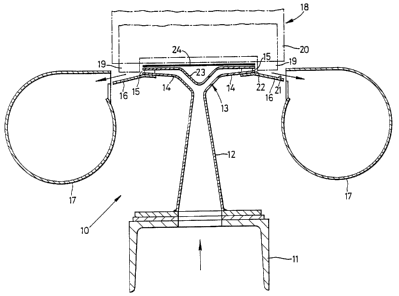Some of the information on this Web page has been provided by external sources. The Government of Canada is not responsible for the accuracy, reliability or currency of the information supplied by external sources. Users wishing to rely upon this information should consult directly with the source of the information. Content provided by external sources is not subject to official languages, privacy and accessibility requirements.
Any discrepancies in the text and image of the Claims and Abstract are due to differing posting times. Text of the Claims and Abstract are posted:
| (12) Patent: | (11) CA 2157511 |
|---|---|
| (54) English Title: | HEATING APPARATUS |
| (54) French Title: | DISPOSITIF DE CHAUFFAGE POUR QUEUES DE PLAQUE |
| Status: | Deemed expired |
| (51) International Patent Classification (IPC): |
|
|---|---|
| (72) Inventors : |
|
| (73) Owners : |
|
| (71) Applicants : |
|
| (74) Agent: | OSLER, HOSKIN & HARCOURT LLP |
| (74) Associate agent: | |
| (45) Issued: | 2005-07-26 |
| (86) PCT Filing Date: | 1995-02-16 |
| (87) Open to Public Inspection: | 1995-08-24 |
| Examination requested: | 2001-09-14 |
| Availability of licence: | N/A |
| (25) Language of filing: | English |
| Patent Cooperation Treaty (PCT): | Yes |
|---|---|
| (86) PCT Filing Number: | PCT/GB1995/000323 |
| (87) International Publication Number: | WO1995/022845 |
| (85) National Entry: | 1995-09-01 |
| (30) Application Priority Data: | ||||||
|---|---|---|---|---|---|---|
|
This invention relates to apparatus for heating the
lugs of battery plates. The apparatus 10 includes a hot
air duct 11 which communicates with a nozzle 12 having a
head 13 that defines a pair of opposite facing nozzles 14.
Each nozzle 14 has an outlet 15 from which extends a
generally flat and divergent plate 16, The plate 16
entrains hot air passing through the outlet 15 into a
generally flat stream so that the hot air impinges on lugs
19, but not of the rest of the group 18 of plates and
separators.
L'invention se rapporte à un dispositif destiné à chauffer les queues des plaques d'un accumulateur. Ce dispositif (10) comprend un conduit d'air chaud (11) communicant avec une buse (12) dotée d'une tête (13) définissant une paire de buses (14) opposées. Chaque buse (14) est dotée d'un orifice de sortie (15) duquel s'étend une plaque (16) généralement plate et divergente. Cette plaque (16) entraîne l'air chaud passant par l'orifice de sortie (15) sous forme de courant généralement plat, de manière que cet air chaud entre en contact avec lesdites queues (19), mais pas avec le reste du groupe (18) de plaques ni avec les séparateurs.
Note: Claims are shown in the official language in which they were submitted.
Note: Descriptions are shown in the official language in which they were submitted.

For a clearer understanding of the status of the application/patent presented on this page, the site Disclaimer , as well as the definitions for Patent , Administrative Status , Maintenance Fee and Payment History should be consulted.
| Title | Date |
|---|---|
| Forecasted Issue Date | 2005-07-26 |
| (86) PCT Filing Date | 1995-02-16 |
| (87) PCT Publication Date | 1995-08-24 |
| (85) National Entry | 1995-09-01 |
| Examination Requested | 2001-09-14 |
| (45) Issued | 2005-07-26 |
| Deemed Expired | 2011-02-16 |
There is no abandonment history.
Note: Records showing the ownership history in alphabetical order.
| Current Owners on Record |
|---|
| TBS ENGINEERING LIMITED |
| Past Owners on Record |
|---|
| HOPWOOD, ROBERT TIMOTHY |